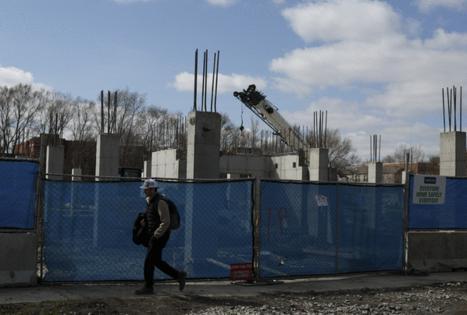Trump tariffs on steel and aluminum could squeeze Chicago apartment developers, leading to higher rents
Published in Home and Consumer News
New tariffs on steel and aluminum could force Chicago apartment developers, already affected by elevated interest rates and soaring labor costs, to further delay breaking ground on new projects.
The White House began implementing tariffs of 25% on global steel and aluminum imports March 12, saying it wants to stimulate domestic production. But experts say tariffs will also make the crucial materials more expensive, forcing developers to pass higher costs onto tenants, or make it tougher to secure financing and kick off construction. Down the road, that could mean higher rents and fewer choices for those looking for housing.
“It’s a very difficult environment for the construction industry,” said Julie Workman, a Chicago-based real estate attorney and partner at Saul Ewing LLP. “Uncertainty and delay can kill deals. Time kills deals.”
The Trump administration further increased uncertainty by announcing a different series of on-again, off-again tariffs on top trading partners such as Canada and Mexico, only to pull back several days later. That makes the overall impact from tariffs difficult to gauge, said Omar Rihani, executive vice president and national residential sector leader for Chicago-based Project Management Advisors.
“There is a lot of noise and the policies often change, so this is all very complex and hard to pinpoint,” he said. “Fundamentally, no one knows, because everything changes day-to-day and sometimes hour-by-hour.”
James McHugh Construction Co., a general contractor that helped build Chicago’s 101-story Vista Tower, hasn’t seen higher costs yet, but price hikes are likely on the way, said Senior Vice President Steve Wiley.
Steel and aluminum are essential for high-rise construction, and are often cheaper to produce in countries such as China, Mexico or Canada, he said. Contractors assemble building frames with heavy steel columns, use steel rebar to reinforce concrete, and form exterior curtain walls with both steel and aluminum. Building mechanical, electrical and HVAC systems also require steel.
“We certainly don’t have the ability to absorb these costs,” Riley said. “Contrary to what many people think, contractors operate on pretty thin profit margins.”
The market for new high-rise construction is already slow, Rihani said. Chicago developers continue hatching plans for new apartment towers, and the Chicago Plan Commission has greenlit dozens of new developments, but high interest rates and borrowing costs have temporarily squelched investment.
Chicago builders had six construction tower cranes in the air as of January, including one for the reconstruction of the James R. Thompson Center into Google’s new headquarters, and another for Related Midwest’s 400 Lake Shore apartment project on the lakefront, according to the newsletter Building Up Chicago. There were 62 Chicago cranes in the air during 2017.
“There is a disconnect right now between the risk and reward for new development, and most major projects are not yet feasible,” Rihani said. “And tariffs are certainly not making it easier.”
The Trump administration announced a new set of tariffs will take effect April 2, covering many products and many other nations, perhaps including Canada, which supplies much of the aluminum and lumber for U.S. construction. It’s not clear how any new tariffs on will impact the 25% aluminum tariff from March 12. Administration officials also hinted they may not implement some of its proposed tariffs.
McHugh Construction just completed the second phase of the Habitat Co.’s 43 Green, a two-building mid-rise apartment complex in Bronzeville, recently started pre-construction work for the 1901 Project, a $7 billion plan to add nearly 10,000 new homes to the West Side neighborhood around the United Center, and began the second phase of Ogden Commons, a $200 million mixed-use project on the West Side.
Wiley’s running the numbers on possible price increases for essential construction materials and said tariffs could push up prices for forest products — including lumber, plywood, cabinets, wood doors and trim — by 10% to 15%. The costs for steel, aluminum and exterior wall systems could rise 15% to 25%.
“We have yet to incur tariff costs,” Wiley said, and it’s unknown how much higher prices for building components will increase the costs of overall projects. “My hunch is that this will be a single-digit number on the overall project cost. However, in a sluggish Chicago commercial construction market, any cost increase, though it may be in the single-digit range relative to the overall project cost, will negatively impact project viability in an already challenging cost environment.”
Buying materials from domestic producers will avoid tariffs, but it’s not a guarantee of lower costs, he added. As the costs of doing business with Canada or Mexico goes up, domestic producers could decide to raise their prices and capture more profit
“It’s a me-too effect,” Wiley said.
The cost of building homes could also rise, Workman said.
“The (National Association of Home Builders) estimates that new tariffs on homebuilding components from China, Canada, and Mexico will add more than $3 billion to material costs, potentially driving up the price of a typical home by over $9,000,” she said. “Those numbers are staggering. The numbers alone should dissuade the administration from implementing tariffs on these products.”
The Trump administration has given a shifting series of rationale for its new tariff regime, occasionally stating they were needed for national security purposes or to pressure other nations to curb illegal immigration and fentanyl trafficking. One consistent message is that tariffs will boost domestic production and American jobs.
“We believe that tariffs are a necessary tool to protect our jobs and our industries from other countries, as well as the labor value of our workers in a globalized market,” Vice President JD Vance said at a Washington, D.C., summit on March 18. “In fact, combined with the right technology, they allow us to bring jobs back to the United States of America and create the jobs of the future.”
More than 26 million tons of steel were imported into the U.S. in 2024, according to the U.S. Department of Commerce. Canadian firms were the leading suppliers, followed closely by Brazilian- and Mexican-based companies.
There is evidence that steel tariffs can bolster the domestic steel industry and create some jobs, said Steven Durlauf, a professor at the University of Chicago Harris School of Public Policy. But by increasing steel prices, tariffs hurt other manufacturers using steel for automobiles, stoves, refrigerators and other products.
“We will see price increases rippling through the system,” he said.
The Trump administration imposed in 2018 a 25% tariff on imported steel, boosting steel prices and cutting imports, according to Commerce data. Domestic steel production rose from 81.6 million tons in 2017 to 87.9 million in 2019, and the workforce increased from about 80,000 to more than 88,000.
But overall, manufacturers using the metal suffered. A December 2019 study by the Federal Reserve Board of Governors showed up to 75,000 jobs in the manufacturing sector were lost due to higher steel costs. The Trump administration reached deals with Canada and Mexico to eliminate the tariffs in 2019.
Creating aluminum industry jobs through tariffs could be even tougher, said Matt Meenan, vice president of the Virginia-based The Aluminum Association. The U.S. imports about half of the aluminum it uses each year, mostly from Canada, and can’t easily boost production.
“Building enough new smelters to make us self-sufficient for our metal needs is a years-if-not decades-long project that would require billions in capital investment and long term, affordable electricity contracts in a tight power market,” Meenan said.
Affordable housing developers need to be especially vigilant this year as tariffs take hold, said Joy Aruguete, chief executive officer of Bickerdike Redevelopment Corp. The company plans to break ground late this year on an 11-story, all-affordable 90-unit building at 5853 N. Broadway in Edgewater.
“We don’t have the flexibility to raise our rents to meet rising costs,” she said. “We’re bidding the project out right now, crossing our fingers and hoping our contractors can hold down prices.”
©2025 Chicago Tribune. Visit at chicagotribune.com. Distributed by Tribune Content Agency, LLC.








Comments